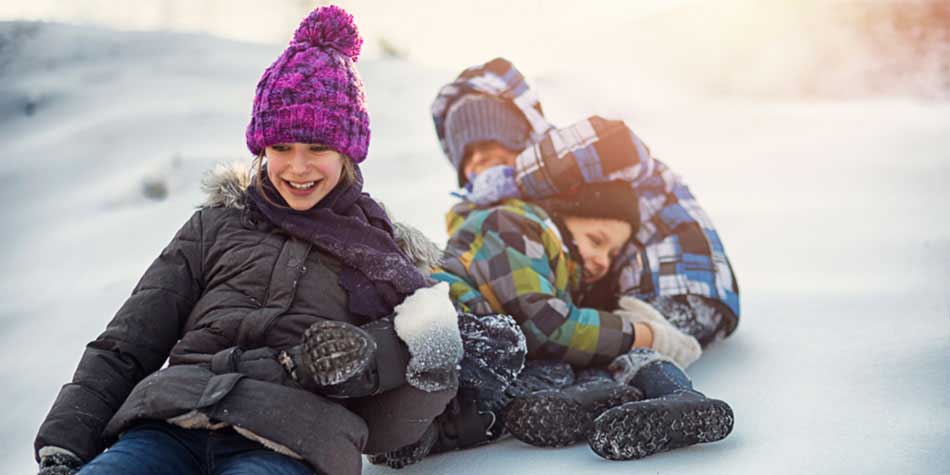Though anyone can slip and fall on the ice, winter is a particularly stressful time for older adults. For several medical and physical reasons, older adults are at a higher rise of falling and fractures than their younger counterparts. Fortunately, there are some steps you can take to help prevent a bad fall and a potential bone fracture this icy winter season.
Tips to Prevent Falls
Accidents happen and are sometimes hard to avoid, but the American Orthopedic Foot & Ankle Society (AOFAS) recommends these tips to help you stay on your feet in the ice and snow:1
- Footwear – Wear proper footwear that provides traction. Soles should be made of a non-slip material, such as rubber, and have grooves that grip walking surfaces. Avoid wearing footwear with smooth soles or heels that can slide easily on slick sidewalks or pavement. Do not assume that athletic shoes, with their grooved soles, will keep you safe on icy streets. Cold-weather boots are your best bet.
- Be on the Lookout for Black Ice – When walking, watch for obvious patches of ice as well as black ice, which is an icy glaze that forms when moisture freezes. Black ice is particularly dangerous because it is difficult to see and you can be fooled into thinking it is just a wet spot on the sidewalk. If you encounter a patch of ice or suspected black ice, step into snow or grass to gain traction and walk around that area.
- Take Your Time – Be sure to give yourself extra time to get where you are going so that you do not have to rush. Adjust your pace and gait when walking in icy areas. Walk with shorter steps and bend your knees slightly so that you can more easily maintain your balance. You should feel like you are shuffling rather than taking normal strides.
- Wear Heavy Socks – Wear heavy socks to add insulation to your cold-weather boots. Change your socks if they become wet and you must remain outdoors. Wet socks and dangerously low temperatures are not a good combination.
- Keep the Outside of Your Home Well-Lit – Make sure that there is enough light outside of your home to make walkways and steps easy to see. In wintertime it gets dark earlier, which only compounds the risk of falling if you cannot see our way. Consider installing handrails to help with balance.
- Be Aware of Medications that Raise the Risk of Falling – Ask your doctor if any of your medicines may cause lightheadedness, drowsiness, or confusion. In addition, have your eyesight checked regularly.
- Stay Strong – Work with your doctor if you have a condition that weakens the bones, such as osteoporosis. Medications, changes to your diet, and weight bearing activities can help slow bone loss and keep you strong.
- Do Not Hesitate to Ask for Help – If you need assistance walking or clearing the snow and ice from your sidewalk and steps, do not hesitate to ask a family member, neighbor, or friend for help.

Factors That Raise the Risk of Falling and Fractures
A risk factor is something that increases your chances of being injured or developing a certain condition. Factors that increase your chance of falling and fracturing a bone include:2,3,4
- Age—Physical and medical conditions put older adults at a higher risk of falling. In 2010, more than 80% of the people hospitalized for hip fractures were age 65 and older, according to the National Hospital Discharge Survey (NHDS).
- Gender—Women are more likely than men to fracture their hips, especially after menopause. 75% of hip fractures occur in women.
- Size—Being small-boned, having a slender body, and low body weight increase the risk of falling.
- Medical History—Fall risk is higher if you have a previous hip fracture, a history of falling, or a family history of fractures later in life. In addition, other medical conditions come with a greater risk of falls and hip fractures, including:
- Osteoporosis —a bone-thinning condition that weakens all bones
- Irregular heart beat or low blood pressure
- Diabetes
- Arthritis
- Parkinson’s disease
- History of stroke
- Vision problems
- Heart failure
- Kidney disease
- Thyroid disorder
- Mental impairments such as Alzheimer’s disease
- Low testosterone in men
- Bone conditions such as osteomalacia (rare)
- Bone tumors (rare)
Other factors that weaken bones and increase the risk of fractures include:
- Poor nutrition
- Poor balance and coordination
- Deficient intake or absorption of calcium and vitamin D
- Physical inactivity
- Smoking
- Excessive alcohol use
- Use of cortisone or other steroids
Why Falls Are So Dangerous for Older Adults
While falling may cause an injury in a person of any age, a fall that results in a broken bone is especially detrimental for older adults. In particular, a fractured hip may result in a dramatically changed lifestyle or even death. According to the American Association of Orthopaedic Surgeons (AAOS),
“Hip fractures can limit mobility and independence. Most hip fractures require surgery, hospitalization, and extended rehabilitation.
Most people who previously lived independently before hip fracture require assistance afterward. This can range from help from family members and home health professionals to admittance to a nursing home or other long-term health facility.”
In addition to the initial trauma of breaking a hip, the elderly tend to suffer more health consequences after the injury that greatly increase the difficulty of recovery, including:
- Infection
- Blood clots
- Stroke or heart failure
Remember, the best treatment is prevention. Be aware of where you are stepping and stay steady on your feet this winter.
$webqFacilityNumber
Need a Physician?